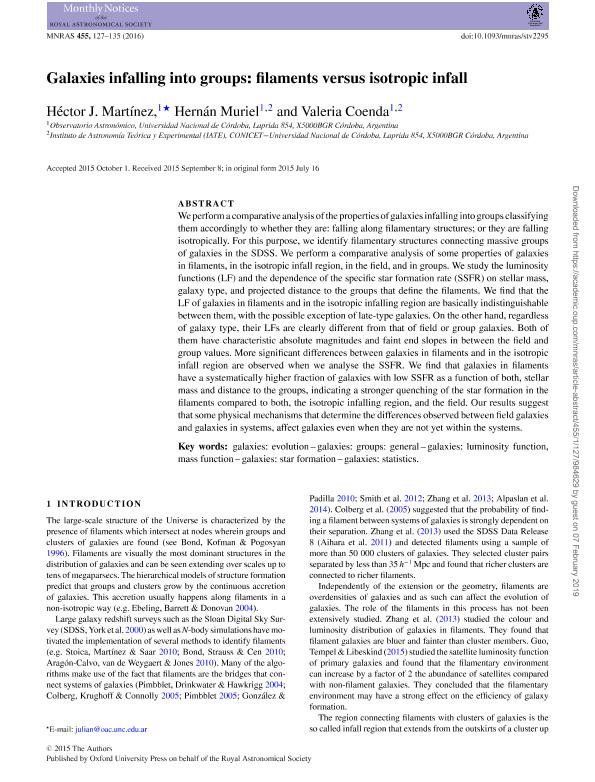Mostrar el registro sencillo del ítem
dc.contributor.author
Martinez Atencio, Hector Julian

dc.contributor.author
Muriel, Hernan

dc.contributor.author
Coenda, Valeria

dc.date.available
2019-02-07T18:48:42Z
dc.date.issued
2015-10
dc.identifier.citation
Martinez Atencio, Hector Julian; Muriel, Hernan; Coenda, Valeria; Galaxies infalling into groups: Filaments versus isotropic infall; Oxford University Press; Monthly Notices of the Royal Astronomical Society; 455; 1; 10-2015; 127-135
dc.identifier.issn
0035-8711
dc.identifier.uri
http://hdl.handle.net/11336/69695
dc.description.abstract
We perform a comparative analysis of the properties of galaxies infalling into groups classifying them accordingly to whether they are: Falling along filamentary structures; or they are falling isotropically. For this purpose, we identify filamentary structures connecting massive groups of galaxies in the SDSS. We perform a comparative analysis of some properties of galaxies in filaments, in the isotropic infall region, in the field, and in groups. We study the luminosity functions (LF) and the dependence of the specific star formation rate (SSFR) on stellar mass, galaxy type, and projected distance to the groups that define the filaments. We find that the LF of galaxies in filaments and in the isotropic infalling region are basically indistinguishable between them, with the possible exception of late-type galaxies. On the other hand, regardless of galaxy type, their LFs are clearly different from that of field or group galaxies. Both of them have characteristic absolute magnitudes and faint end slopes in between the field and group values. More significant differences between galaxies in filaments and in the isotropic infall region are observed when we analyse the SSFR. We find that galaxies in filaments have a systematically higher fraction of galaxies with low SSFR as a function of both, stellar mass and distance to the groups, indicating a stronger quenching of the star formation in the filaments compared to both, the isotropic infalling region, and the field. Our results suggest that some physical mechanisms that determine the differences observed between field galaxies and galaxies in systems, affect galaxies even when they are not yet within the systems.
dc.format
application/pdf
dc.language.iso
eng
dc.publisher
Oxford University Press

dc.rights
info:eu-repo/semantics/openAccess
dc.rights.uri
https://creativecommons.org/licenses/by-nc-sa/2.5/ar/
dc.subject
Evolution
dc.subject
Galaxies
dc.subject
Galaxies
dc.subject
Galaxies
dc.subject
Galaxies
dc.subject
Galaxies
dc.subject
General
dc.subject
Groups
dc.subject
Luminosity Function
dc.subject
Mass Function
dc.subject
Star Formation
dc.subject
Statistics
dc.subject.classification
Astronomía

dc.subject.classification
Ciencias Físicas

dc.subject.classification
CIENCIAS NATURALES Y EXACTAS

dc.title
Galaxies infalling into groups: Filaments versus isotropic infall
dc.type
info:eu-repo/semantics/article
dc.type
info:ar-repo/semantics/artículo
dc.type
info:eu-repo/semantics/publishedVersion
dc.date.updated
2019-02-07T14:56:22Z
dc.journal.volume
455
dc.journal.number
1
dc.journal.pagination
127-135
dc.journal.pais
Reino Unido

dc.journal.ciudad
Oxford
dc.description.fil
Fil: Martinez Atencio, Hector Julian. Consejo Nacional de Investigaciones Científicas y Técnicas. Centro Científico Tecnológico Conicet - Córdoba. Instituto de Astronomía Teórica y Experimental. Universidad Nacional de Córdoba. Observatorio Astronómico de Córdoba. Instituto de Astronomía Teórica y Experimental; Argentina
dc.description.fil
Fil: Muriel, Hernan. Consejo Nacional de Investigaciones Científicas y Técnicas. Centro Científico Tecnológico Conicet - Córdoba. Instituto de Astronomía Teórica y Experimental. Universidad Nacional de Córdoba. Observatorio Astronómico de Córdoba. Instituto de Astronomía Teórica y Experimental; Argentina
dc.description.fil
Fil: Coenda, Valeria. Consejo Nacional de Investigaciones Científicas y Técnicas. Centro Científico Tecnológico Conicet - Córdoba. Instituto de Astronomía Teórica y Experimental. Universidad Nacional de Córdoba. Observatorio Astronómico de Córdoba. Instituto de Astronomía Teórica y Experimental; Argentina
dc.journal.title
Monthly Notices of the Royal Astronomical Society

dc.relation.alternativeid
info:eu-repo/semantics/altIdentifier/doi/http://dx.doi.org/10.1093/mnras/stv2295
dc.relation.alternativeid
info:eu-repo/semantics/altIdentifier/url/https://academic.oup.com/mnras/article/455/1/127/984629
dc.relation.alternativeid
info:eu-repo/semantics/altIdentifier/url/https://arxiv.org/abs/1510.00390
Archivos asociados
